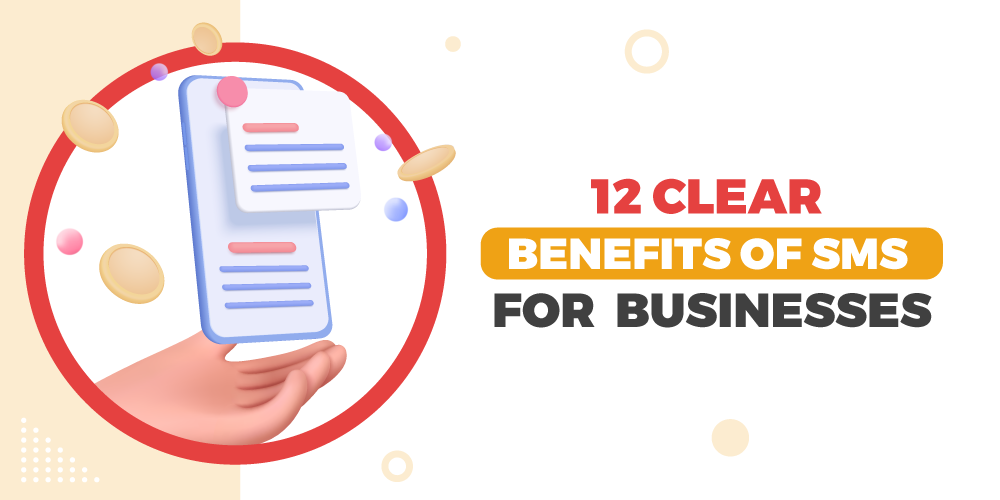With the advancement of technology in the Philippines and around the world, it’s no surprise to see brands shifting their marketing strategies towards newer, emerging channels.
According to HubSpot, 58% of marketers have found experiential marketing – that is, augmented reality marketing – to be effective. Moreover, social media marketing continues to be among the strongest channels that marketers use. But with consumers being 35x more likely to open mobile messages than email, there’s one channel that remains timeless: SMS.
SMS is a communications channel that doesn’t seem to be going away anytime soon. In fact, it’s one of the most effective marketing channels your business can utilize.
Almost everyone in the Philippines has a working mobile phone with SMS capabilities, meaning that your potential audience reach through SMS is vast. But that isn’t all.
The infographic below will highlight 12 business SMS benefits and why you should consider including this channel in your next marketing strategies.

Understanding the Benefits and Advantages of SMS for Businesses
-
Your message has a high chance of being read
It doesn’t take much research to understand that people are constantly on their phones. It’s been found that Filipinos between the ages of 16 and 64 spend an average of five hours and forty-seven minutes on their phones daily. That means that if someone started using their phone after waking up at 7 AM, the only time they would put it down would be after lunch.
With the amount of time the average Filipino spends on their phone, it’s no surprise to see that SMS receives a 97% read rate. Moreover, it’s forecasted that, out of a population of over 113 million, almost Filipinos will have smartphones in 2023, giving you the chance to reach a wide audience through your SMS marketing campaigns.
-
SMS campaigns are budget-friendly
Effectively promoting your business on social media or getting the first search ranking on Google’s search engine results page tends to be an expensive and tedious process.
Companies typically dedicate $500 – $50,000 per month to their digital marketing efforts. It can be challenging to break through the noise if you don’t have to budget for it. But SMS won’t cost you nearly as much.
With Semaphore, for instance, a 160-byte SMS costs one credit, or P0.50 (exclusive of VAT). So, if you wanted to send an SMS to 1000 people, it would cost only P500 or less than $10 (USD).
A key advantage of SMS marketing in this case is that you can increase your reach and stretch your budget further.
-
SMS is a more personal channel than others
With the greater use of digital services, the personalization of messages is becoming non-negotiable. According to McKinsey, 71% of consumers expect companies to provide them with personalized experiences – and 76% negatively react when it doesn’t occur.
Since SMS is one of the few types of marketing where you can reach your customers directly, you’re better able to personalize your messages. With the help of services such as Semaphore, you can customize your SMS even further by easily including each sender’s name instead of a general greeting.
-
There are few barriers to delivery
One of the challenges you’ll need to overcome with email marketing is avoiding automatic filters. Gmail, for instance, notoriously has a Promotions tab where 93% of email campaigns are filtered to. This was a feature to help declutter the user’s inbox.
Since most promotional emails are filtered to a hidden tab, only 19.2% are eventually read.
On the other hand, the advantage of SMS marketing is that it allows you to reach a typically unfiltered space: the user’s SMS inbox. This is why your messages are more likely to get opened than if they were emails.
-
SMS campaigns are flexible
There are two types of messages you can send out in your SMS campaign: promotional and transactional.
Promotional messages are mainly about promoting products with a specific call-to-action, whether using a coupon or offering discounts. Messages with offers have been found to have over a 9% higher click-through rate than other channels.
On the other hand, transactional messages are geared more towards sending announcements and additional important information to your customer. This includes any policy changes your business has, tracking information on a package your customer ordered, or a one-time pin (OTP) they need to use to log in to their account.
-
SMS campaigns are relatively simple to set up
SMS campaigns aren’t as complicated as social media or email marketing campaigns. For instance, you won’t have to worry about designing visual collateral to go along with your marketing copy.
Instead, all it takes is for you to compose a 160-character message. Additionally, it can be made much easier with services such as Semaphore‘s, which allows you to send SMS messages in bulk using templates, avoiding the need to rewrite each message repeatedly.
-
You have access to valuable metrics
Another clear advantage when sending SMS or text messages in bulk through software such is that you can easily track your SMS campaigns with metrics such as open, click, and response rates.
Since you can interact with customers directly, you also have access to a message history to further help you gather valuable insights and track responses to know how to improve your business and products.
-
Allows customers to opt-in or out simply
Signing up for an SMS campaign is a straightforward process for your customers. All they would need to do is text a specific number with a text code to opt-in automatically. This simplicity allows you to grow your contact database much faster as well as increase customer satisfaction.
-
Customers have a higher chance of replying
When compared to emails, SMS recipients are 134% more likely to respond. This is encouraging for you as a business, especially because 60% of consumers want to respond to the messages they receive.
Responding directly to your customers also helps you build longer-term relationships with them, nurturing them to make a purchase and helping them become advocates for your business.
-
You face limited competition
An effective way to beat the competition is to avoid it. 61% of marketers aren’t taking advantage of SMS marketing, which bodes well for you if you are.
Instead of devising ways to differentiate yourself in a sea of emails or shell out thousands to compete against other social media posts, you can reach customers directly through their SMS inbox. With little competition, you can more easily stand out to your customers.
-
You can expect a high ROI
With how cost-effective SMS campaigns are, it’s no surprise that you can expect a high return on investment when you use them. It’s been found that CTAs of SMS are acted on by 33% of recipients, with 47% of them going on to make a purchase.
Moreover, marketers can expect an up to 500% return on their investments using a text marketing campaign. You can then funnel the savings from SMS marketing towards other initiatives such as growing your business or improving your products.
-
SMS is ideal for time-sensitive information
SMS is an ideal channel for limited-time offers, and time-sensitive information since deploying campaigns happens almost instantly. An example of time-sensitive promotional messages you could send could be about a flash sale you have that ends within the day.
Additionally, a transactional SMS you could send is a message allowing customers to track their order on their way to them.
SMS is advantageous because they’re short, simple, and important messages you can easily send to your customers at any time, regardless of whether or not they’re connected to the internet.
Take Your Marketing Further with SMS
SMS is far from extinct. Businesses not incorporating SMS into their marketing campaigns are missing out on favorable upsides that would be difficult to achieve via other channels.
The advantages of SMS, including the high chance of your messages being read paired with the low relative cost, can yield a high return on investment for your business. Additionally, it’s simple to set up and a convenient channel to start conversations with your customers and gain insights.
It’s about time to seriously consider incorporating SMS into your marketing campaign!
If you’re looking to power your business with SMS, contact Semaphore for best-in-class business SMS solutions.



